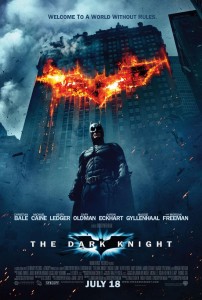The Dark Knight
 I finally saw The Dark Knight recently. If you haven’t seen the film, don’t read these comments, because I’m going to reveal things about the plot herein.
I finally saw The Dark Knight recently. If you haven’t seen the film, don’t read these comments, because I’m going to reveal things about the plot herein.
First, this is a very good movie, but you didn’t need me to tell you that. The reviews have been very good and, while a lot of people complained about the “Batman growl” that Christian Bale does to disguise his voice, it’s really very realistic when you consider that any idiot could easily recognize Bruce Wayne’s natural speaking voice. What else would you do if you were in Batman’s position, talking to people Bruce Wayne talks to on a regular basis? Why, you’d make your voice as strange as possible and hope nobody put two and two together, that’s what.
That’s really a minor nit in a superb piece. While Heath Ledger’s Joker certainly does some scene stealing, the movie is well balanced and gives Batman plenty of screen time. It also gives him the better moral dilemma with which to grapple. You see, so far, both of director Chris Nolan’s Batman films have relied very heavily on explicit themes with moral overtones. Batman Begins is about fear — learning to recognize it, deal with it, overcome it, and accept it — and also about establishing and living by a moral code.
The Dark Knight is about the nature of heroism and villainy and includes many examples of each. The overarching theme is that Batman is not a “hero” — not a paladin figure at all, but rather a dark operative who does what heroes cannot do. He is an operative of justice who adheres to a darker moral code (but to a code nonetheless). Crusading DA Harvey Dent, by contrast, is a paladin and is referred to as a “white knight” more than once.
The Joker, “agent of chaos” that he is, seeks to prove that even a paladin like Dent can become a villain — and Dent himself predicts this when he utters the defining line of the film, saying that one either dies a hero or lives long enough to become a villain.
The Joker’s morality play encompasses the entire city when he threatens to blow up a hospital if a specific citizen — who is appearing on a talk show threatening to “out” Batman’s identity — is not murdered within the hour. Civilian Gothamites and police alike try to murder the man, while others try to save him and the hospitals are frantically evacuated.
Later, the Joker sets up two ferries with explosives. On one ferry, convicted criminals are being shipped off the island on which Gotham is situated. On the other, ordinary citizens are trying to escape the chaos. Both boats are informed that they have until midnight to use the detonators they have been given — detonators that blow up the bombs in the other boat. Veteran character actor Tommy “Tiny” Lister has a superb cameo as a hulking convict who threatens one of the law enforcement officers on the ferry. Give him the detonator, Lister rumbles, and he’ll do “What you should have did ten minutes ago.” The man hands over the detonator — and Lister throws the detonator out the window, proving that even a villain can be a hero when he has time truly to think about his actions.
When neither ferry blows, Batman uses this information against the Joker. Ledger’s Joker is jubilant over how he’s proven that anybody can fall, that anyone can become a villain — until Batman points out that on those two ferries are several hundred citizens of Gotham who have proven that there are still plenty of heroes left in the world.
The movie sets a fast pace and never really gives the viewer time to savor what he or she has just seen, because there’s always more to take in. Any of several elements within this movie could have made up the greater portion of a feature film. Dent’s horrific Two-Face could have carried a film as the primary villain, for example, but here he’s simply an afterthought, a consequence of the Joker’s moral lesson for the city of Gotham.
The Joker himself, who tells a series of lies explaining his facial scars (for his white face paint is just that; this is a Joker who wears makeup, rather than someone who’s fallen into a vat of chemicals per the original Joker origin story and the Tim Burton vision of Batman), really deserves an origin story. There’s a certain power in never knowing how he becomes who he becomes, but it would still be interesting to see.
The only low marks the film deserves come in the casting of Maggie Gyllenhaal as Rachel. While not unattractive, and certainly up to the role in terms of acting ability, Gyllenhaal is simply to odd looking ever to be the beautiful woman who’s supposed to have captured the hearts of two different men. It’s not believable that both Dent and Wayne are hopelessly in love with her and, frankly, when she gets blown into a fine red mist, I was extremely happy. Not only will we not have to endure her presence in a sequel (or be reminded of the Tom Cruise Shadow of Xenu that fell over Katie Holmes, who of course was Rachel in the first Nolan Batman film), but once she’s blown up we don’t have to put up with her in The Dark Knight. As a dead motivation she’s much more effective than as a live love interest.
The rest of the film is very slick and well-executed. Gotham is slightly less claustrophobic and also more believable as a city than ever before; I found myself truly absorbed by it. Relatively minor roles within the movie are played with gusto by superb casting choices, such as a fattened-up Eric Roberts as a mob boss or Michael Jai White as a criminal underlord who runs afoul of the Joker’s temper. The mentally unbalanced people who follow the Joker as true believers are also well played, and it’s a nice touch to think that the only people crazy enough to follow the Joker are, well, crazy.
To say that Ledger redefines the Joker as the Joker was meant to be is simply to repeat what many critics have already written. The Joker as psychopathic, sociopathic, and schizophrenic clown is truly the Doctor Moriarty to Bruce Wayne’s Sherlock Holmes (remember that Batman is referred to as “The Detective” by Rais Al Ghul in the comics) — a villain evil enough and deadly enough to be a true match for Batman.
In the comics, the Joker killed one of the Robins and paralyzed Commissioner Gordon’s daughter (just because he could). He’s an evil son of a bitch who really ought to be killed for the good of all, and this sets up the moral dilemma that is the heart of the Batman, the soul of the Dark Knight. Does one kill when everyone seems to demand it? How does one justify murder in any context? That’s the true moral test here, the one with which Batman grapples most becuase it is the one that forged him.
I’m eager for a third Nolan-directed Batman film. There’s been some early talk of Brian Austin Green as “The Riddler.” We can only hope this comes to pass (Green shows real acting chops in Terminator: The Sarah Connor Chronicles on Fox). The studio will have its work cut out for it to give us a villain who is as believable, and as dangerous, as Ledger’s Joker — or the briefly glimpsed but truly terrifying Two Face, for that matter. This is the type of adventure the movies were meant to be, and the type of entertainment that justifies charging more for a “small” soda and a “small” bag of popcorn than for the admission to the film.

